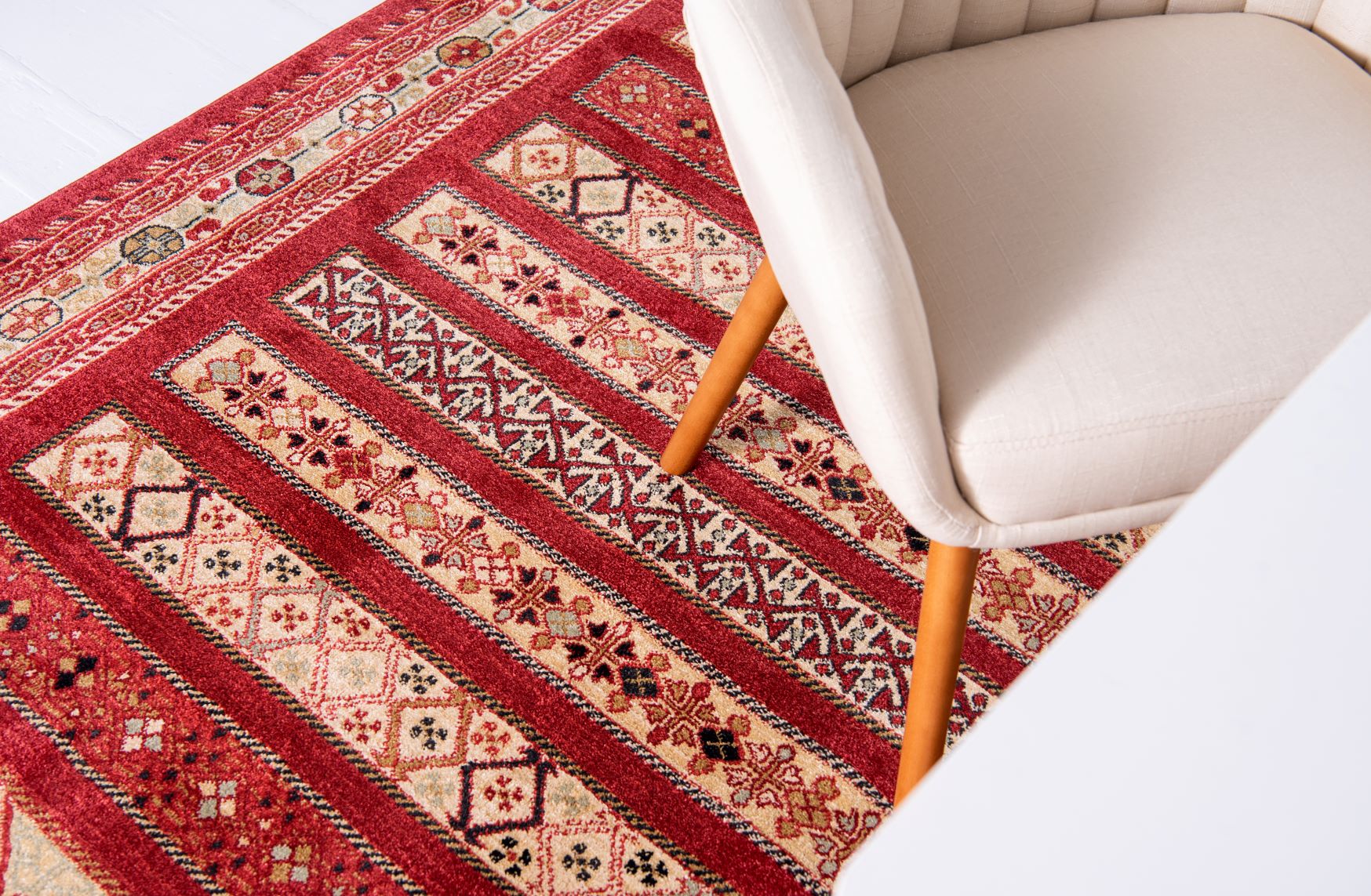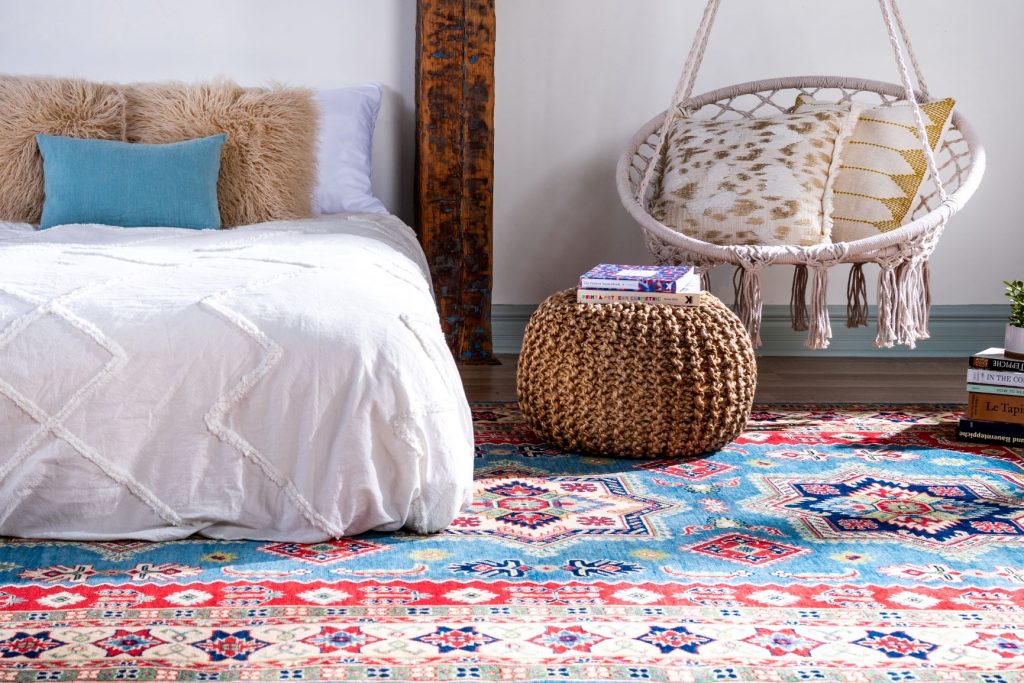Origins and History
The original Kazak rugs were not linked to a particular country or ethnic group, but rather to a general region. They were woven by women in the geographic region of the Caucasus and further south. Originally woven by nomadic Turks who arrived in the region following their western migration in the 11th century.
In the 1800s Kazak (or Kazaak) Rugs were status symbols that incorporated strands of gold in the weave. They were found in grand churches, palaces, and the homes of the wealthier classes. They were used to cushion and lead the way for royalty, the red carpet of its time. Kazak carpets not only covered floors for the region’s elite, but also hung on walls as works of art, as well as to create warmth and absorb sound.
Along the way these rugs shed some preciousness in favor of rugged authenticity. Eventually the design and methodology for weaving Kazak rugs moved west into present day Afghanistan. However, recent history forced some weavers to flee the country to escape persecution by the Taliban. Many of these Afghan refugees began settling in Pakistan as early as the 1980s. This resettlement allowed for a revival of the motifs and patterns of Kazak rugs. New available materials and a more muted color palette allowed for the reinvention of the Kazak carpet. Today, these rugs made primarily in Pakistan are not only some of the most popular Kazaks, they are in fact some of the most popular rugs on the market.
Material and Weave
Similar to the majority of Oriental and Persian rugs, Kazak rugs are likewise predominantly made of wool and are hand-knotted. Kazak rugs made in Pakistan are usually made using a tighter weave and have a high knot density. Armenian Kazak rugs are thicker, have a looser weave, and are made using a coarse shiny wool.
Modern weavers in Pakistan who employ the progressive Kazak techniques painstakingly recreate the timeworn look of the original pieces. They spin the wool tightly, taking care not to snap it, before they knot the yarn. This allows for a flatter look akin to those of vintage rugs. For the weave, sometimes they knot with subtle shifts in color to create an abrash effect. The edges of the width of the rug are typically finished with selvages. Ends of the length are finished with fringes on both sides by some weavers. Others choose to finish one end with fringe and the other with a clean hem. The pile of Kazak rugs, particularly those woven in Pakistan, are cut ultra short and then the rugs are put through an antiquing process. The rugs are stone washed, which mutes the colors and give the rugs a beautiful soft sateen finish that looks aged.
Design and Color

Kazak carpets draw heavily from folk art prevalent in the Caucasus region. The overarching design through line for Kazak rugs are geometric patterns. Various traditional shapes such as medallions, squares, and diamonds dominate Kazak designs. Very occasionally weavers add fauna and flora as well. One of the distinct shapes common in Kazaks, but rarely found in Persian rugs, is the hooked diamond. Another uniquely Kazak shape is the cross, particularly with the Armenian Kazaks that are woven by Christian weavers.
Each Kazak rug typically employs four to eight colors even when the resulting look appears quasi monochromatic. Brightly colored rugs favor dominant reds and blues, enhanced often by green and ivory secondary colors. This is to draw the eye towards dramatic geometric shapes.
By contrast, the antiqued Kazaks made by Afghans who emigrated to Pakistan use a subtler color palette. Traditionally these weaver only had access to black, white, strong red, and the gray scale. Once resettled, they began to use indigo, various shades of green as well as blue-greens like turquoise. They added rust, light orange, pinks, ivory and brown, as well as all the tan shades in between.
Up until the year 2000 most Kazaks were made using natural, mostly vegetable, dyes. Since then, a large portion of weavers have moved to a chemical process to meet increased demand and create a more durable product. Some weavers however remain steadfast in their use of an all-natural dye process.
Contemporary Styling
Trends and tastes evolve, but one of the best ways to complement an edgy industrial interior with surfaces that are natural or unfinished, is with a Kazak rug. These floor coverings pair well with exposed brick, steel/metal architectural supports, exposed ductwork, and finished and unfinished concrete. Kazak rugs also pair well with natural wood and everything rugged or vintage.
Some designers, however, prefer to complement minimalist spaces with Kazak rugs to add warmth. Still others like to see traditional furniture enhanced with the graceful geometry of Kazak rugs on the floor. Whatever the taste or preference, the addition of a Kazak rug generally indicates a well-traveled owner.

